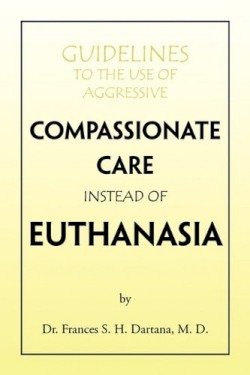Guidelines To the Use of Aggressive Compassionate Care Instead of Euthanasia
An individual who takes a shortcut to eternity may become totally separated from God, according Frances S. H. Dartana. Though the word “euthanasia” technically means “good death,” she denounces both active and passive euthanasia as violence.
“One can be reassured that there is no reason to interrupt anything; either forwards [promoting quicker death] or backwards [postponing death],” Dartana writes. She suggests alternative care for patients with terminal illness, including professional counseling, responding to emotional pain, praying, encouraging visitors, managing pain effectively, and providing nutrition. The author argues that patients should receive fluids even when nutrition is detrimental to the dying process. However, she appears to contradict herself by using the expression “late natural death” to refer to the court-ordered removal of the feeding tube from “Terry Schiafo [sic].”
Dartana is a Canadian physician and licentiate of the Medical Council of Canada who spent ten years working in the field of tropical medicine. After retiring from her forty-year medical practice, she took up translation work. The author’s own progressive disease requires regular use of a wheelchair and twenty-four-hour care.
Numerous medical references back up Dartana’s ideas, but her documentation system is inconsistent and confusing. Only the first seven footnote numerals correspond to notes at the bottom of the page. The others either refer to entries in the bibliography or to nothing at all.
The book’s target audience is adult Christians, especially those who have relatives with a terminal illness or who are ill themselves. The author uses verses from the New Testament and Ecclesiastes to demonstrate that people have an eternal spirit. For example, Ephesians 2:6 mentions sitting in heavenly places with Jesus. Dartana nicely references chapters and verses in parentheses but fails to specify the version of the Bible she cites.
The book’s long title clearly identifies its subject, but some of this information would have worked better in a subtitle. An apparent appendix, which contains letters and informative reprinted articles against euthanasia, lacks a label. This is one of several formatting slip-ups.
This topic is of vital importance in our high-tech society, and Guidelines may leave readers rethinking their values regarding life and death. Unfortunately, it has serious problems relating to punctuation, typographical errors, and especially citation of references.
Disclosure: This article is not an endorsement, but a review. The publisher of this book provided free copies of the book and paid a small fee to have their book reviewed by a professional reviewer. Foreword Reviews and Clarion Reviews make no guarantee that the publisher will receive a positive review. Foreword Magazine, Inc. is disclosing this in accordance with the Federal Trade Commission’s 16 CFR, Part 255.

